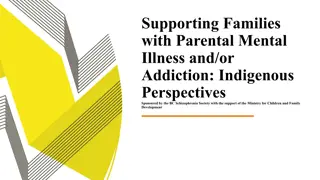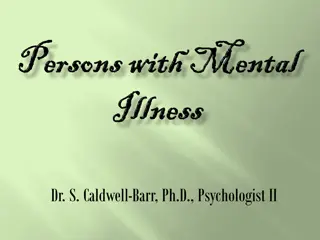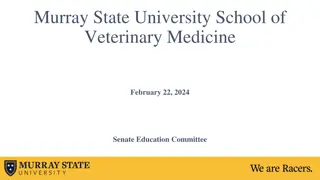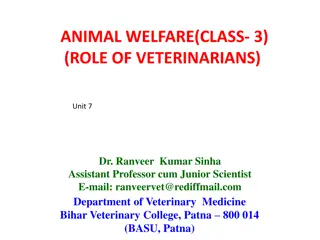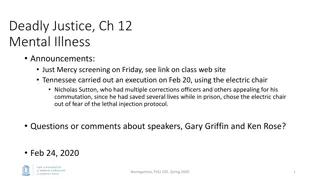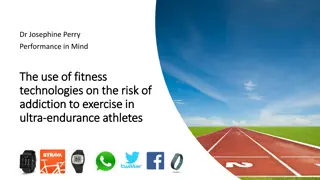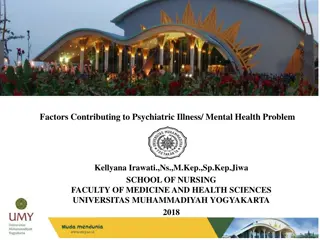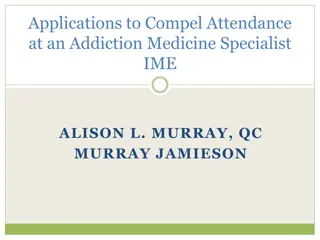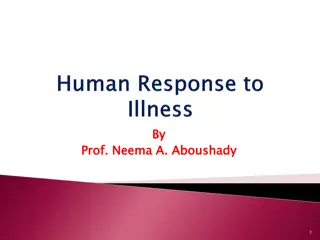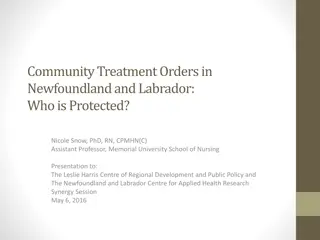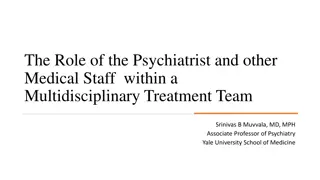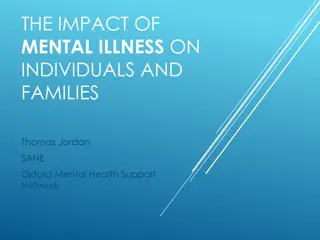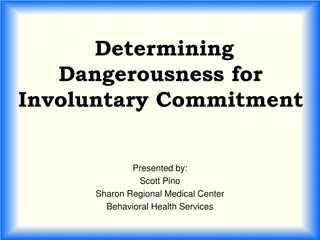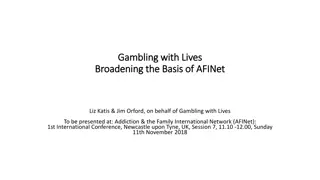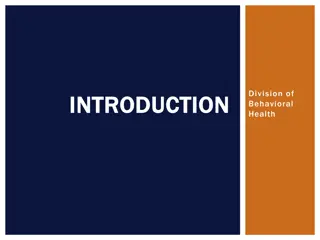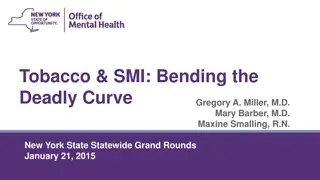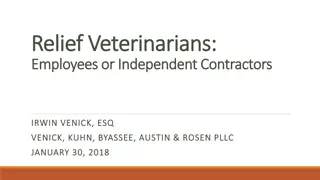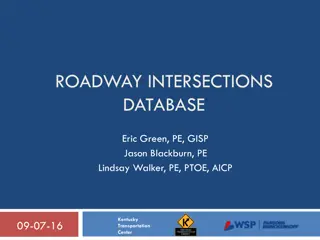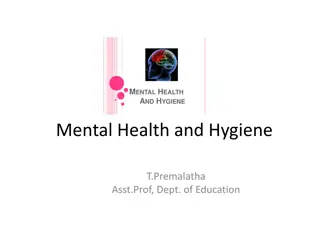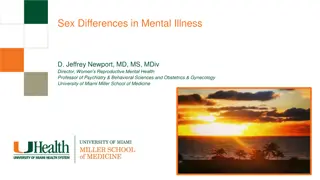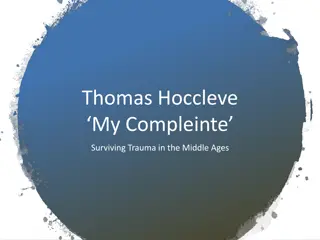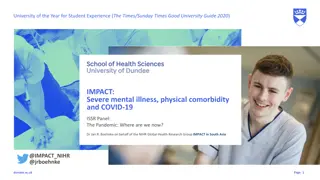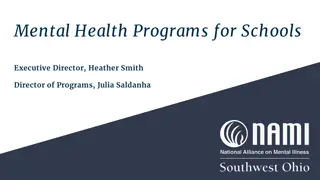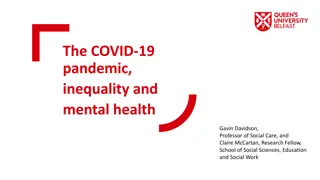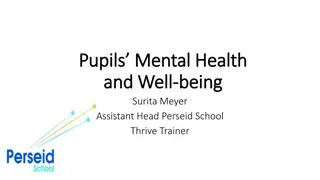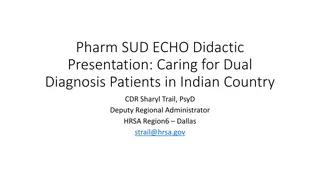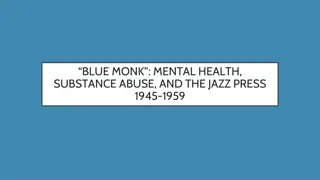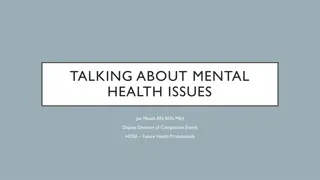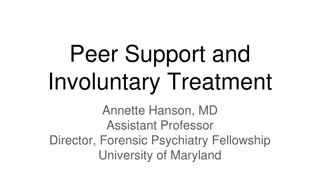Understanding the Intersection of Addiction and Mental Illness in Veterinarians
Explore the profound impact of addiction and mental illness on veterinarians, highlighting the biological and environmental components, the prevalence of serious mental illness, the challenges in seeking mental health help, and the heightened risk of suicide within the veterinary profession. Promote education, awareness, and destigmatization to support the well-being of veterinary professionals.
Download Presentation

Please find below an Image/Link to download the presentation.
The content on the website is provided AS IS for your information and personal use only. It may not be sold, licensed, or shared on other websites without obtaining consent from the author. Download presentation by click this link. If you encounter any issues during the download, it is possible that the publisher has removed the file from their server.
E N D
Presentation Transcript
Now Then Owner of Loving Hands Animal Clinic Board Certified Active in GVMA Active in Education Married in 1995 to the world's greatest man Productive, Happy, Well Managed Mental Illness Relapse Prevention Plan Suicide Prevention Plan Long Term Recovery Undiagnosed Mental Illness Suicide Imminent Incapable of Honesty, Delusional Incapable of Job Performance Absolutely Isolated Active Eating Disorder
Educate you about the disease of Addiction and Mental Illness Dispel prejudice and misinformation, remove stigmas Provide resources Provide prevention strategies which contribute to overall wellness in the profession Convince you that you are likely to encounter these issues in your practice lifetime My goal is NOT to tell you not to drink.
A continued use of a substance or behavior in the face of consequences. Biological Basis (Amygdala, dopamine, seratonin) Environmental, social components. Recognized by the AMA (1955 Alcoholism) & DSM4 (including diagnostic criteria, prognostic information. Is NOT a moral issue Denial is a component Tolerance develops Relapse is a potential
6% (1/17) people have serious mental illness in the US DSM criteria, illness is not a choice or a moral issue Less than 1/3 of adults and of mentally ill children get mental health help Multiple Forms Need help from trained mental health care provider (therapy, medication, other) Must rule out physical illness to diagnose (e.g. hypothyroid) Genetic, chemical (neurotransmitter), hormonal, situational/traumatic components ACE study (ACEStoohigh.com) 10% of DVM s report current serious psychological distress. US population 7.9 % Depression: DVM s 36.7% of females, 24.5% males. General population 22% in females, 15% in males.
DVMs 4x greater than normal population DVMs suicidal ideation females 19%, males 14%. General population 7.1% females, 5.1%males. 10th leading cause of death. More suicides than homicide + war together 25 attempts for each success in the general population Men guns, women overdose
Joe Gloyd in JAVMA " The veterinary student profile includes characteristics such as intelligence, self- starter, highly motivated, capable, set lofty goals, tend to self criticize, disappointment in the face of achievement and lost self esteem." These characteristics are common to addicts, ACOA s and those of us prone to depression and suicide. I would challenge you. These are characteristics of many of our staff as well.
Highly driven, deeply caring people Unique financial and ethical tensions High levels of stress, low level of well trained para- professional support Little stress management or wellness training in veterinary curriculum Self sufficiency is prized, self reliance is killing us
Little emphasis on community or support in the profession Competition rather than colleagueship Entitlement (44% of pharmacists self prescribe. How many DVM's?) Easy access to drugs with lower accountability than in other professions.
Addiction General population 10% drug addiction, 30% alcoholism (Maybe higher in health care professionals) Mental Illness 1/6 in general population What is the rate in people who go into animal health care? Suicide DVM 4x rate of general population DVM 2x rate of other health care professionals What is the rate in our staff? Each suicide touches at least 6 other people or more
Suicidal Ideations, discussion of suicide Depression or anxiety, prolonged period Diagnosed mental illness Use of alcohol or drugs Diagnosed of chemical dependency Compulsive food behavior Diagnosed eating disorder Exposure to domestic violence Exposure to violence outside the home Exposure to incarceration (jail or prison) 85% 96% 88% 92% 77% 58% 39% 58% 58% 58% All questions were phrased, you or anyone in your life N=26
Initially overachievers "Top of the heap" Erratic performance, mood swings Emotional volatility or extreme lassitude Martyr or victim Deterioration in appearance Dishonesty, elaborate excuses Isolation, withdrawal Financial distress Fascination with drug box, pharmacy, etc. The job is the last to go; Family, physical and emotional health will be impacted first.
Personality change Inability to cope Strange or grandiose activity/ideas Excessive anxiety Mood swings Prolonged sadness, apathy Changes in sleeping or eating Substance abuse Talking about self harm or suicide Risk seeking behavior
Mental illness Significant loss Substance abuse History of trauma or abuse (ACE questionnaire) Physical illness Impulsivity Feeling hopeless Family history, exposure to suicide Access to means Lack of health care
I S Substance Abuse Ideation P Purposelessness A Anxiety T Trapped H Hopeless W Withdrawal A Anger R Recklessness M Mood change
Culture of self reliance Personality profile of those entering profession Stigma for seeking help Lack of awareness Lack of information on how to help Managerial burdens (little training, hard to find help) Long hours, heavy work load Financial Stress Poor work life balance Difficult client relationships Availability and knowledge of means of ending life Burn out rate Inadequate professional support
Addicts, people contemplating suicide, and sometimes those with mental illness are typically incapable of recognizing the reality of their situation. Action by a concerned party is often required to save a life. Please consider helping. Please consider helping.
Planned Focuses on facts and events Loving and non-judgemental but clear and firm Caring confrontation detailing losses and consequences of substance abuse Ends with choice of consequences verses help (AA, NA meeting, treatment) Must involve appropriate professional Help to guard against risk of self-destructive behavior on the part of the addict.
Caring, concerned Let the person talk, don t censor, judge or discount, do not immediately suggest solutions Ask direct questions Are you thinking about killing yourself? How would you do it? Plans? If suicidal ideations call hotline or if imminent call 911 Help person find mental health resources or bring them with you Stay with the person while they make the call Involve a mental health professional We are vets not therapists Make plans for tomorrow
Lives Families Careers Please do not do Nothing Nothing!
You didnt cause it You can't cure it You can't control it
Anguish, guilt, rage, anger and the like are common feelings directed toward the addict or to someone who commits suicide. The disease of spouseaholism or codependency is a common finding in family members. Family and friends may recover even if the addict does not. Alanon Nami.org SAVE at utk.edu
Is not a salvage operation Is the beginning of a life worth living Is not about bad people getting good Is about ill people getting well Results in the return to function of people who have something to give back to society and our profession
A desire to get well A desire to accept assistance Active participation in 12 step meetings Putting something in place of substance (i.e. new coping techniques, stress management, recreation, community, spirituality) Accountability Wellness committee Random testing Peer support and groups
Mental health professional Support network Coping skills training Reprogramming negative self talk, affirmations, guided imagery Spirituality for some people Service animals, emotional support animals Medication for some people Healthy life style (food, exercise, sleep, recreation) Focus, dedication, sometimes outside monitoring
Disseminate information, educate, facilitate interventions or make referrals Advocate and mentor, liaison for employer monitoring contracts
States Wellness Committees AVMA 800-321-1473 ext. 625 avma.org > Wellness www.al-anon.alateen.org www.alcoholics-anonymous.org www.na.org (Narcotics Anonymous) Listings in phone directory Suicide Prevention Lifeline 800-273-TALK www.suicidepreventionlifeline.org www.nami.org www.samhsa.gov www.nmha.org utk.edu > SAVE



